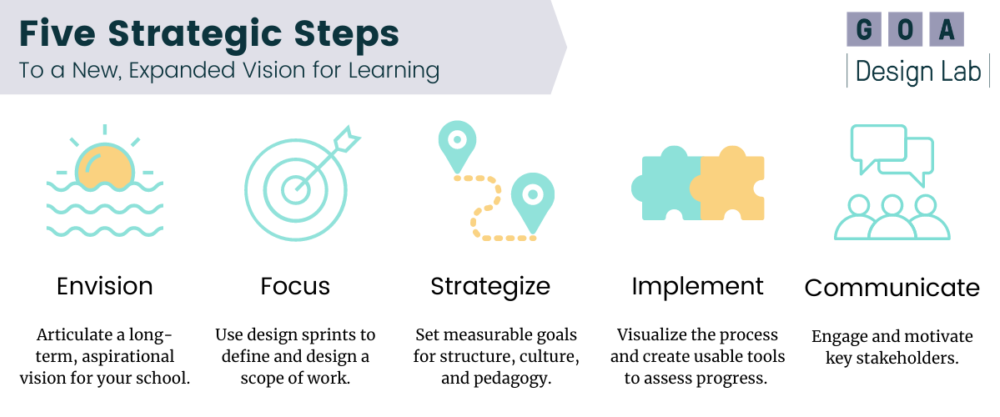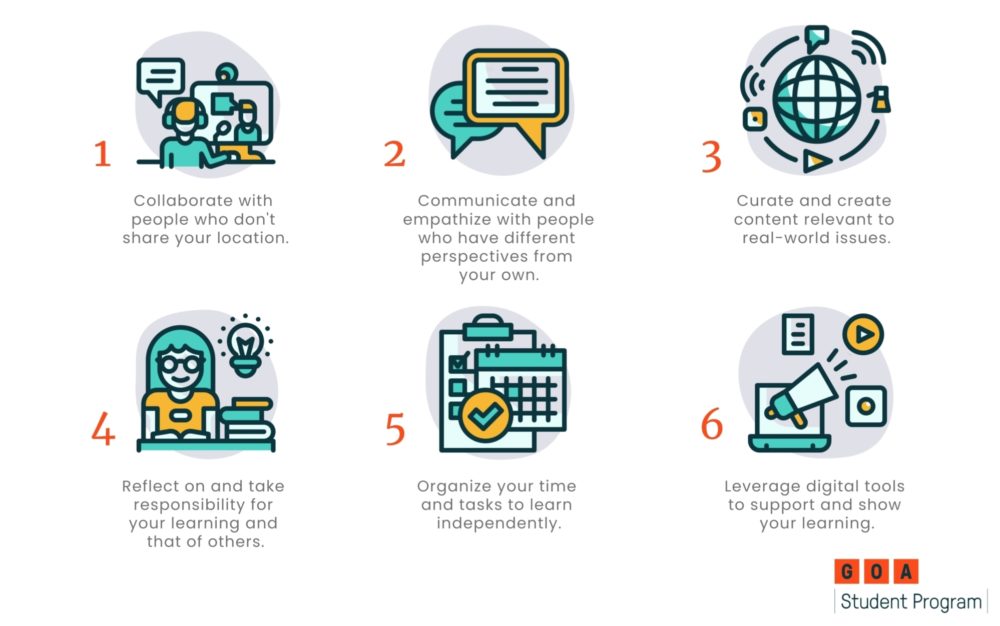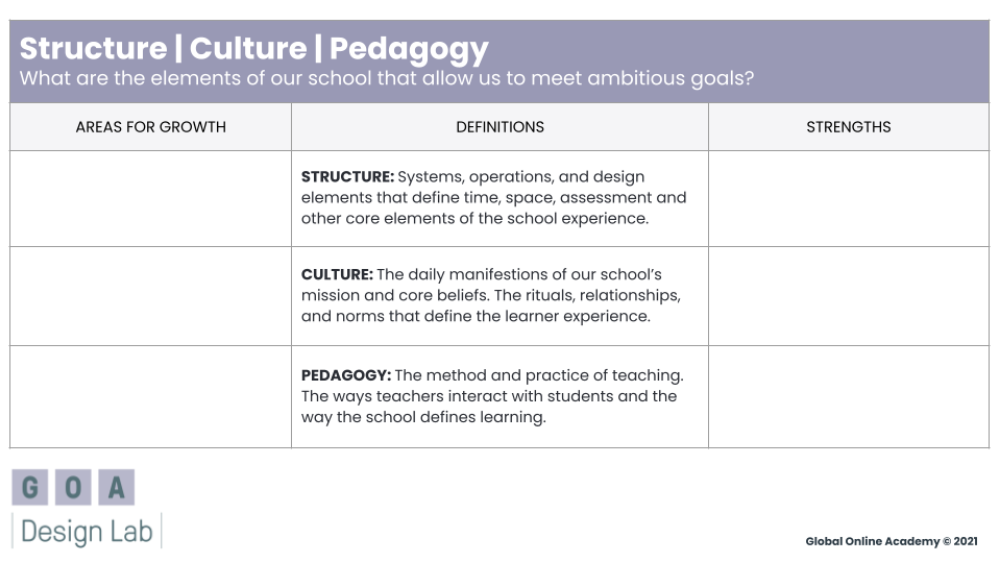Five Strategic Steps to Design for the Future of School
What do we now think is possible in schools that we thought was impossible a year ago?
Schools have a new sense of potential when it comes to learning and teaching. Constraints that we used to think of as intractable in academic programs—time, space, assessment, accessibility, etc.—have fallen away. The awareness and skillsets of teachers and students when it comes to technology for learning have been permanently expanded. The attention and commitment of families to the role of education in their lives has never been stronger.
In looking ahead to post-pandemic learning, school leaders need to shift from reacting to challenges to planning for possibilities. As Peggy Holman has written, disruption causes change, and our ability to find the possibility in that change depends on how we reflect on and engage with what we learn from disruption. This is especially important when it comes to the future of learning in schools: our reaction to the disruptions of the last year and a half will define how and how much our academic programs grow and evolve.
At GOA, we see multiple paths forward for schools. The future may involve pursuing brand new possibilities for expanding the school experience; it may involve addressing acute problems revealed over the past year; it may involve reinforcing and reinvesting in core values and practices; it may be a combination of these things. We believe, and know from experience, that an intentional process to identify, explore, and choose the possibilities to pursue is critical to making mission-aligned decisions that empower your communities to engage with and support a new vision for learning.
GOA launched the Design Lab to guide school leaders through this process. We’ve identified five key steps: Envision, Focus, Strategize, Implement, and Communicate.

1. Envision
We must create time and space to rest and to reflect on what we’ve experienced since early 2020. We are emerging from a long, intense period of crisis, one where we were processing new, ever-changing information and circumstances and one where we were supporting students, staff, and their families (and ourselves) through confusion, stress, and trauma. Finding ways to focus on wellness and reflect collaboratively will help clarify a vision for the future.
A vision is a long-term, aspirational portrait of how our school will look different. If strategy is a process, vision is an outcome. The Envision process should imagine exciting possibilities in addition to identifying jobs to be done. Part of this work is gathering insights and experiences beyond ourselves as school leaders—through surveys, focus groups, community engagement, etc.—and enriching and/or challenging our own ideas with those of our colleagues, students, and their families. This is especially important for crafting visions that entail systems-level change: reimagining structures for equity and access, deep integration of online and hybrid learning, or adopting competency-based learning, for example.
New ideas should be cross-referenced with the foundational mission and values that define our school. For example, when GOA made the decision to pursue competency-based learning in 2015, we analyzed five years of student and teacher feedback data and revisited documents from our founding in 2011. Much of the language you see in our Student Program’s six core competencies is pulled directly from our original charter. They articulate the alignment between new ideas and the ongoing, long-term work of GOA.

2. Focus
Moving from Envision to Focus is about defining a scope of work. While a vision should articulate an aspiration as well as a rationale for pursuing that aspiration, a scope should name the project(s) that the school will pursue to realize that vision. For example, a school might envision personalized learning for all students and focus the work on embedding high-quality online learning in the student experience at all grade levels.
Defining a scope of work often involves deepening our understanding of new concepts or programs. Finding and filling gaps in our knowledge keeps us out of the “expertise trap.” Curating relevant research, exploring learning models within and beyond education, and connecting with new voices and perspectives to test our ideas are all strategies to define and refine the scope.
One way to apply that new knowledge is to engage in a design sprint: a rapid, collaborative process that produces a prototype for discussion and iteration. For example, in GOA’s work with schools on graduate profiles, leadership teams engage in design sprints to produce profile prototypes. Not only does a design sprint advance thinking through hands-on work, but it also surfaces questions and important considerations as the leadership team strategizes for how to bring strategic work to the wider community.
3. Strategize
At this stage, schools should proritize and organize the work ahead as well as identify clear, measurable outcomes by which they can measure success. This might be a moment where an existing strategic plan needs to be updated or a new one created.
At GOA, we focus on three pillars of school: structure, culture, and pedagogy. Consider the simple single-point rubric below. By articulating strengths in each category, we can identify the people, work, and programs already fulfilling our vision. The job of school leaders then becomes elevating, celebrating, and investing more deeply in those people and work. By articulating our areas for growth, we can identify opportunities to create new programming, bring in outside expertise, and/or allocate resources. Rubrics like these can also be used to assess progress during the Implementation phase.

4. Implement
As you prepare for Implementation, reflect: What is your school’s previous experience with strategic change? What approaches have (not) worked? What makes this new strategy similar to or different from previous efforts?
There are foundational elements to implementation: setting quarterly and annual goals, scheduling regular intervals to review and assess progress, identifying the person and team who will lead implementation, and aligning implementation plans to your school’s schedule/calendar and other initiatives already in progress. Tailoring these elements to your school should involve creating shared resources and language about the process.
Leaning into visualization can be helpful here. For example, using visual thinking to create maps or timelines can simplify and make more accessible a daunting, complicated process. Using templates like the hybrid learning worksheet below can align teams as well as organize and present information clearly and concisely. The added benefit is that artifacts like these support transparency about the process and facilitate effective communication.

5. Communicate
This step is one of the most important, but it might also be one of the most overlooked. Designing a strategic communication plan ensures the way your team talks about this exciting, important initiative is consistent, focused, and engaging. Because academic programs involve a diverse group of stakeholders, publishing your plans in a transparent and user-friendly way is important.
When it comes to communicating about change, we are looking to do more than just inform; we are looking to motivate. It’s difficult to think of a learning initiative worth pursuing that won’t require the engagement and collaboration of many different people in a school community. How are you as a school leader communicating about the purpose, relevance, and benefits of this new strategy? How are you grounding it in a larger story about your school? GOA has used Marshall Ganz’s public narrative framework as a tool to align communication strategy with purpose and core values.
What’s Next?
We are in a moment where we are deeply exhausted yet sense a window of opportunity. As Jal Mehta of the Harvard Graduate School of Education says in this interview, the next 15 months will define the long-term impact of the last year and a half on schools. Making the decision to prioritize strategic planning now may be a difficult one, but it may also be the right one in preparing for your school’s future.
To learn more about how school leaders are thinking about the future of education, read these articles:
- Four Pathways for School Leaders Preparing for a Post-COVID World
- Eight Predictions for Education in 2021
- Six Ideas School Leaders Want to Keep Post-COVID
The GOA Design Lab offers strategic consulting services for school leaders seeking to pursue new visions for learning at their schools. We customize our process to your school’s specific goals and timeline. Learn more about the Design Lab’s other services and products.


